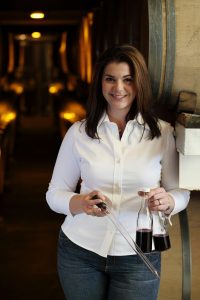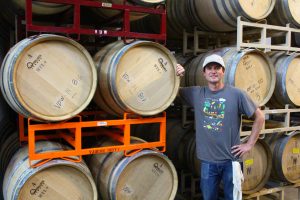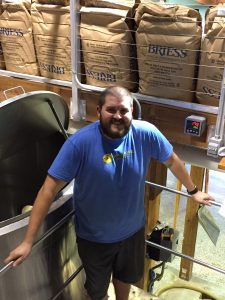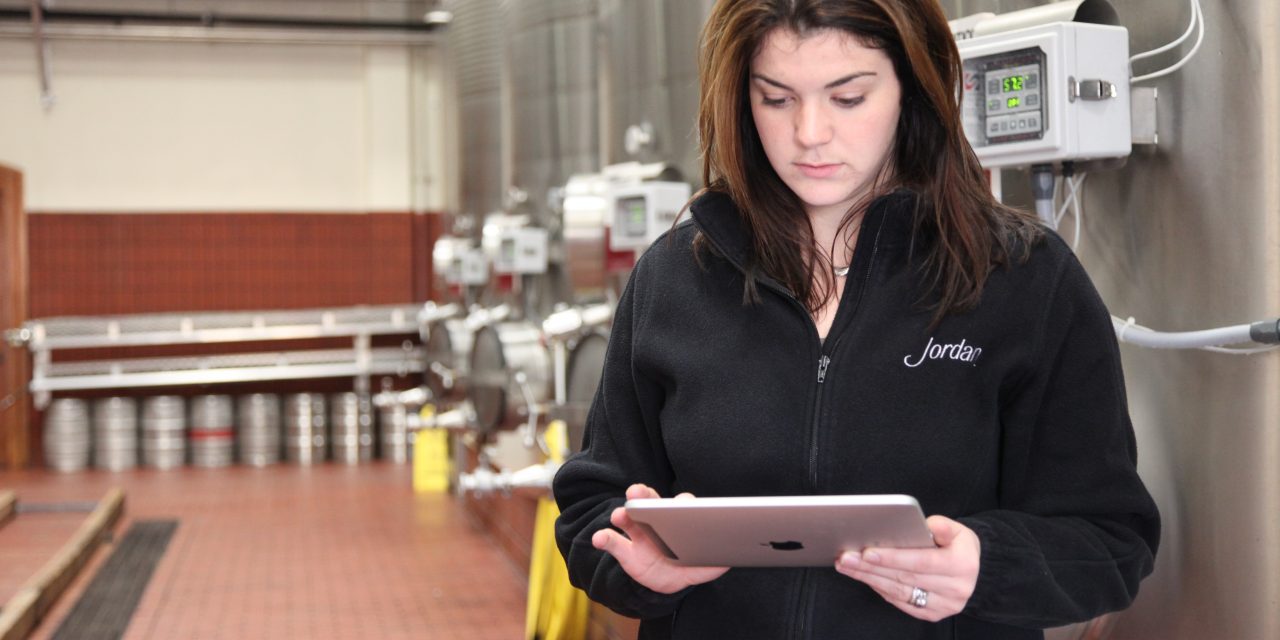In craft beverage operations, every detail must be tracked for internal purposes and for various regulatory agencies. Producers of every size are now leaning on software to boost productivity, eliminate guesswork and maintain accurate records in case of an audit.

Jordan Vineyard & Winery uses TankNet and The Winemaker’s Database to keep harvest and production organized and running smoothly. Pictured: Associate Wine maker Maggie Kruse
Jordan Vineyard & Winery in California’s Sonoma County uses TankNet to monitor fermentation. Associate winemaker Maggie Kruse says it’s vital for scrutinizing temperatures. “I can set a temperature for a Chardonnay fermentation and then check it from my phone or iPad. I can set alarms and if the fermentation is very vigorous and getting too high, it’ll send me text messages until I address the issue.”
Previously, tank temperature problems required an in-person trip to manually correct. But now, Kruse says, she can roll over in bed in the middle of the night and fix it via her phone. “During harvest that extra hour of sleep is essential, so I’m in love with the program.” During fermentation, there are always some lots that are concerning, but the ability to check from anywhere gives her peace of mind.
Kruse also relies on The Winemaker’s Database for data entry and work orders, and says if there’s an audit, she can provide precise details to the TTB. Plus, it keeps track of varietal and appellation percentages, which aids in blending decisions. “It eliminates guesswork,” she reveals. “We’re not trying to calculate our blends. We can do mock blends on the computer. It lets us keep our lots separate and blend later.”
Kruse estimates dramatic time savings. “It would take probably six hours a day to do this versus 30 minutes!”
Custom Software for a Custom Crush
At Vinify Wine Services, a custom crush facility in Santa Rosa, Calif., owner Justin Lattanzio recognized the right software would be key after his first harvest 10 years ago. He invested in creating a proprietary program called CrushSoft.

Matt Duffy of Vinify Wine Services
Production Manager Matt Duffy explains that clients log into their account to create work orders, such as pulling samples, topping barrels or scheduling a racking. When completed, it sends a notification to the winemaker. “It’s a streamlined way to get all our work into one place and for our clients to communicate their needs without using email or text messages.”
With 20 winemakers needing work done on any given day, a simple and efficient system for all parties is imperative, as is record keeping. “Our program took some fine tuning and multiple revisions over the years as our business developed,” Duffy says. “We’re making wines for many different labels under one roof. Most of our clients hold their own bond. They’re alternating proprietors who need to interface with the bulk wine when it’s in the winery as much as we do. We tailored CrushSoft to suit what we do in the winery and what our clients need to do.”
Likewise, a custom solution is the answer for international Treasury Wine Estates, where Jennifer Metcalfe works with eight California wineries as senior manager of planning and optimization in Winery Operations for Treasury Wine Estates. She worked closely with ZAM Apps owner Shawn Zizzo as he and his team developed vinoEZ.

Treasury Wine Estates’ Jennifer Metcalfe works with eight California wineries as senior manager of planning and optimization.
Network Planning helps coordinate space for harvest, as Metcalfe looks at inbound and outbound shipments of wine, plus harvest intake: “We put all that information in with a time-phased approach to show who needs additional storage at what point in time.”
As the fruit comes in, it’s managed with Harvest Scheduler, which tracks tonnage, blocks, destination and delivery timing. Bulk Wine Shipping aids with tracking data for blending, storage or bottling. The Blend Planning Modules (BPM) helps with tracking the steps required to pull a red blend together with the appropriate lead time. Metcalfe elaborates, “The wines for luxury will be one blend and that’s it for the vintage. But for our commercial blends, we may do four to six blends before we get to the next vintage, so BPM helps us communicate all the steps to pull a blend together in a consistent way across the network.”
vinoEZ also creates a production plan for cellar team, detailing the work and priority for the coming week, letting them quickly determine next steps after completing a task. “It’s a great tool to help the cellar become more efficient,” says Metcalfe. “People don’t feel like they’re just reacting to problems. They have a sense of accomplishment.”
Wine and Cider Crossover
At family-owned Blue Mountain Cider Company and Watermill Winery in Milton-Freewater, Ore., director of operations Andrew Brown upgraded from spreadsheets to vintrace for both facilities in July 2013. “We use vintrace more frequently in our cider making operation,” he says. “We typically get to a finished product that’s ready to be packaged in 17 to 24 days. We have to track every process we do in an extremely tight timeframe.”
Blue Mountain is also a cider co-packer for five other producers. “We package 12 to 15 times per month,” Brown discloses. “About 1,000 cases per day, per shift, and vintrace gives us the ability to document, track and report from fruit to bottle.”
The most important factor for Brown is peace of mind: “What it really gives is the assurance of good documentation. The most important part of keeping records is the ability to access them when necessary. I had an audit two-and-a-half years ago, and ultimately, vintrace was the reason it went so well. I was able to access information from two to three years back without a hiccup. For that, it’s invaluable.”
Eliminating Spreadsheets

Saltwater Brewery’s Dustin Jeffers
At Saltwater Brewery in Delray Beach, Fla., head of operations Dustin Jeffers uses Orchestrated Beer for inventory, invoicing, fermentation tracking, ordering, quality control, TTB reports and even personnel costs.
Jeffers explains the ordering process for the 20-barrel brewery: “My recipes are all scaled from 18 to 24 barrels. Orchestrated Beer shows cost per barrel, whether it’s 21 barrels or 24 barrels. At each stage, when a billing material goes into the system, the program takes it out of my inventory. For example, if we use 1,200 pounds of a certain grain, once I run that beer through the system it’ll take that 1,200 pounds of grain out of my inventory. When I do my grain orders, I check my inventory and it’s up-to-date. I don’t have to maintain a separate sheet for grain orders.”
Orchestrated Beer also helps Jeffers project his work. “I plan out how much grain and hops I need for the next month or two of brews, and it’ll show me when I’ll run out and on what day I should order.” That alone eliminated two other spreadsheets he used to keep.
When Jeffers enters purchase orders from his distributors, the program calculates when the stock will run out. “I’ll know how much beer is needed when, and I can move the brew around to make sure we’re good. We went from one distributor to five in a year, and the system really helped our production,” he says.
Whether you build your own or go with existing software, the time savings is significant, production is efficient and compliance reporting becomes less of a hassle — not to mention saving your butt in the case of an audit.










